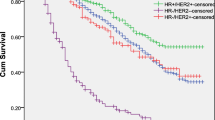Summary
Breast cancer is the second leading cause of cancer death in women today. Once breast cancer metastasizes to bone, mortality increases. Thus, there is an urgent need to identify patients with high risk of bone metastasis, and to find predictive factors for the occurrence of bone metastasis at an earlier stage of breast cancer. Three hundred and sixty patients with pathologically proved breast cancer visiting the Department of Nuclear Medicine for whole body bone scan from January 2006 and January 2009 were investigated in this study. Clinicopathological information was obtained, which consisted of age, menopausal status, clinical staging, lymph node stage, histological grade, the expression of estrogen receptor (ER), progesterone receptor (PR) and epidermal growth factor receptor 2 (HER2). Correlation between bone metastasis and the associated factors was tested by using the Chi-square test. A Cox multivariate analysis was used to assess the factors which independently contributed to survival after bone metastasis in breast cancer patients. Survival curves were drawn for metastasis-free interval and the independent factors which contributed to survival, using the Kaplan-Meier method. Twenty-four patients were excluded from subsequent analysis. Three hundred and thirty-six enrolled patients ranged in age from 22 to 77 years (mean, 47.8 years). ER/PR status [ER(+) vs. ER(−), χ 2=4.328, P=0.037; ER(+)PR(+) vs. ER(+)PR(−), χ 2=4.425, P=0.035] and histological grade (χ 2=7.131, P=0.028) were significantly associated with bone metastasis. ER status (x 2=8.315, P=0.004) and metastasis-free interval (χ 2=6.863, P=0.009) were independent prognostic factors for survival in breast cancer patients with bone metastasis. Our study suggested that ER/PR status and histological grade are risk factors for the development of bone metastasis in breast cancer patients. However, ER status and metastasis-free interval are independent prognostic factors for survival in breast cancer patients with bone metastasis. Breast cancer bone metastasis has its unique characteristics, which is helpful to choose the appropriate treatment for breast cancer patients with bone metastasis.
Similar content being viewed by others
References
Pretz DJ, Powles TJ, Milan J, et al. Detection of breast carcinoma metastases in bone: relative merit of X-rays and skeletal scintigraphy. Lancet, 1983,2(8350):613–616
Coleman RE, Rubens RD, Fogelman I. Reappraisal of the baseline bone scan in breast cancer. J Nucl Med, 1988,29(6):1045–1049
Rodriguez-Pinilla SM, Sarrio D, Honrado E, et al. Prognostic significance of basal-like phenotype and fascin expression in node-negative invasive breast carcinoma. Clin Cancer Res, 2006,12(5):1533–1539
Koizumi M, Yamada Y, Takiguchi T, et al. Bone metabolic markers in bone metastasis. J Cancer Res Clin Oncol, 1995,121(9–10):542–548
Cox DR. Regression models and life-tables. J R Stat Soc, 1972,34:187–220
Sobin LH, Wittekind Ch. In: Sobin LH, Wittekind Ch. TNM Classification of Malignant Tumors. 6th ed. Geneva: Wiley-Liss, 2002, 131–141
Elston CW, Ellis IO. Pathological prognostic factors in breast cancer: experience from a large study with long term follow-up. Histopathology, 1991,19:403–410
Martin TJ, Moseley JM. Mechanisms in the skeletal complications of breast cancer. Endocr Relat Cancer, 2000,7(4):271–284
Janicek MJ, Hayes DF, Kaplan WD. Healing flare in skeletal metastases from breast cancer. Radiology, 1994,192:201–204
Baum M. The changing face of breast cancer-past, present and future perspectives. Breast Cancer Res Treat, 2002,75(Suppl 1):s1–s5
James JJ, Evans AJ, Pinder SE, et al. Bone metastases from breast carcinoma: histopathological radiological correlations and prognostic features. Br J Cancer, 2003,89(4):660–665
Williams MR, Todd JH, Ellis IO, et al. Oestrogen receptors in primary and advanced breast cancer: an eight year review of 704 cases. Br J Cancer, 1987,55(1):67–73
Arpino G, Weiss H, Lee AV, et al. Estrogen receptor-positive, progesterone-receptor negative breast cancer: association with growth factor receptor expression and tamoxifen resistance. J Natl Cancer Inst, 2005,97(17): 1254–1261
Loi S, Haibe-Kains B, Desmedt C, et al. Definition of clinically distinct molecular subtypes in estrogen receptor-positive breast carcinomas through genomic grade. J Clin Oncol, 2007,25(10):1239–1246
Coleman RE, Smith P, Rubens RD. Clinical course and prognostic factors following bone recurrence from breast cancer. Br J Cancer, 1998,77(2):336–340
Callahan R, Hurvitz S. Human epidermal growth factor receptor-2-positive breast cancer: current management of early, advanced, and recurrent disease. Curr Opin Obstet Gynecol, 2011,23(1):37–43
Author information
Authors and Affiliations
Corresponding author
Rights and permissions
About this article
Cite this article
Chen, J., Zhu, S., Xie, Xz. et al. Analysis of clinicopathological factors associated with bone metastasis in breast cancer. J. Huazhong Univ. Sci. Technol. [Med. Sci.] 33, 122–125 (2013). https://doi.org/10.1007/s11596-013-1083-1
Received:
Published:
Issue Date:
DOI: https://doi.org/10.1007/s11596-013-1083-1




